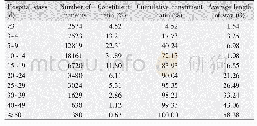《Table 1–Average yield (kg ha-1) in the leading soybean-producing countries in SSA during 2012–2016.
 提示:宽带有限、当前游客访问压缩模式
提示:宽带有限、当前游客访问压缩模式
本系列图表出处文件名:随高清版一同展现
《"History, current status, and prospects of soybean production and research in sub-Saharan Africa"》
In SSA,South Africa is the largest soybean producer in2016,followed by Nigeria,Zambia,and Uganda[8].Other SSAcountries,including Zimbabwe,Malawi,Ghana,Sudan,and Ethiopia,have also experienced sizeable commercial soybean expansion.Planting area and production in the leading soybean-producing countries in SSA during 1987–2016 are shown in Figs.1 and 2,respectively.Average yields in South Africa,Nigeria,Zambia,and Uganda during 2012 to 2016 are presented in Table 1.In 2016,South Africa(2290 kg ha-1)and Zambia(1940 kg ha-1)had the highest average yields,followed by Nigeria(960 kg ha-1)and Uganda(600 kg ha-1)in SSA.During the last two decades,Nigeria,South Africa,and Uganda have maintained their positions as leading soybean-producing countries in the region.The reasons behind their successful soybean production include(1)governmental policies to produce food locally rather than depending on imports;(2)progressin research to improve varieties and practices adapted to a wide range of agro-climatic zones;(3)emphasis on developing recipes that substitute or incorporate soybeans in traditional foods;(4)willingness of local manufacturers to use soybeans in baby foods and for vegetable oils and animal feeds;and(5)promotion of soybean production and utilization by organizations,agricultural development projects,hospitals,schools,and local governments.South Africa and Nigeria offer the best examples in SSA of the potential for soybean production and use.Soybean production has increased dramatically,from 84,000 t in 1987 to1,320,000 t in 2016 in South Africa and from 40,000 t in 1987 to680,000 t in 2016 in Nigeria(Fig.2).
| 图表编号 | XD0012320200 严禁用于非法目的 |
|---|---|
| 绘制时间 | 2018.06.01 |
| 作者 | Dalia Mohamedkheir Khojely、Seifeldin Elrayah Ibrahim、Enoch Sapey、Tianfu Han |
| 绘制单位 | MOA Key Lab of Soybean Biology (Beijing),Institute of Crop Sciences,Chinese Academy of Agricultural Sciences、Gezira Research Station,Agricultural Research Corporation (ARC)、Gezira Research Station,Agricultural Research Corporation (ARC)、MOA Key Lab of Soy |
| 更多格式 | 高清、无水印(增值服务) |





